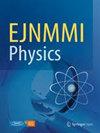Prediction of [177Lu]Lu-DOTA-TATE therapy response using the absorbed dose estimated from [177Lu]Lu-DOTA-TATE SPECT/CT in patients with metastatic neuroendocrine tumour
IF 3
2区 医学
Q2 RADIOLOGY, NUCLEAR MEDICINE & MEDICAL IMAGING
引用次数: 0
Abstract
Peptide receptor radionuclide therapy (PRRT) with [177Lu]Lu-DOTA-TATE has shown efficacy in patients with metastatic neuroendocrine tumours (NETs). Personalised dosimetry is crucial to optimise treatment outcomes and minimise adverse events. In this study, we investigated the correlation between the tumour-absorbed dose (TAD) estimated from [177Lu]Lu-DOTA-TATE SPECT/CT and the therapeutic response. A retrospective analysis was conducted on patients with advanced well-differentiated NETs grades 1–3 who underwent PRRT and exhibited greater uptake than liver on pre-therapeutic [68Ga]Ga-DOTA-TOC PET/CT. Target lesions were selected based on the RECIST 1.1 and PERCIST 1.0 criteria using [177Lu]Lu-DOTA-TATE SPECT/CT and pre-therapeutic contrast-enhanced CT scans. For anatomical image analysis, the sum of the longest diameter (SLD) of the target lesions was measured using the RECIST 1.1 criteria for patient-based analysis and the longest diameter (LD) of the target lesion using the RECIST-L criteria for lesion-based analysis. Standardised uptake values (SUVs) were measured on SPECT/CT images, and TADs were calculated based on the SUVs. Dosimetry was performed using a single SPECT/CT imaging time point at day 4–5 post-therapy. Statistical analyses were conducted to investigate correlations and determine the target lesion responses. Twenty patients with primary tumour sites and hepatic metastases were included. Fifty-five target lesions, predominantly located in the pancreas and liver, were analysed. The cumulative TAD (lesion-based analysis: r = 0.299–0.301, p = 0.025–0.027), but not the cycle 1 SUV (lesion-based analysis: r = 0.198–0.206, p = 0.131–0.147) or cycle 1 TAD (lesion-based analysis: r = 0.209–0.217, p = 0.112–0.126), exhibited a significant correlation with the change in LD of the target lesion. Binary logistic regression analysis identified the significance of the cumulative TAD in predicting disease control according to the RECIST-L criteria (odds ratio = 1.031–1.051, p = 0.024–0.026). The cumulative TAD estimated from [177Lu]Lu-DOTA-TATE SPECT/CT revealed a significant correlation with change in LD, which was significantly higher for the cumulative TAD than for the cycle 1 SUV or TAD. A higher cumulative TAD was associated with disease control in the target lesion. However, considering the limitations inherent to a confined sample size, careful interpretation of these findings is required. Estimation of the cumulative TAD of [177Lu]Lu-DOTA-TATE therapy could guide the platform towards personalised therapy.利用从转移性神经内分泌肿瘤患者的[177Lu]Lu-DOTA-TATE SPECT/CT中估算出的吸收剂量预测[177Lu]Lu-DOTA-TATE治疗反应
使用[177Lu]Lu-DOTA-TATE的肽受体放射性核素疗法(PRRT)对转移性神经内分泌肿瘤(NET)患者有显著疗效。个性化剂量测定对于优化治疗效果和减少不良反应至关重要。在这项研究中,我们调查了[177Lu]Lu-DOTA-TATE SPECT/CT 估算的肿瘤吸收剂量(TAD)与治疗反应之间的相关性。我们对接受了PRRT且在治疗前[68Ga]Ga-DOTA-TOC PET/CT显示摄取量大于肝脏的1-3级晚期分化良好NET患者进行了回顾性分析。使用[177Lu]Lu-DOTA-TATE SPECT/CT和治疗前对比增强CT扫描,根据RECIST 1.1和PERCIST 1.0标准选择靶病灶。在解剖图像分析中,基于患者的分析采用 RECIST 1.1 标准测量靶病灶的最长直径之和(SLD),基于病灶的分析采用 RECIST-L 标准测量靶病灶的最长直径(LD)。在 SPECT/CT 图像上测量标准化摄取值 (SUV),并根据 SUV 计算 TAD。剂量测定使用治疗后第 4-5 天的单个 SPECT/CT 成像时间点进行。统计分析用于研究相关性和确定靶病变反应。共纳入了 20 名原发肿瘤和肝转移患者。对55个主要位于胰腺和肝脏的靶病灶进行了分析。累积 TAD(基于病灶的分析:r = 0.299-0.301,p = 0.025-0.027),而非周期 1 SUV(基于病灶的分析:r = 0.198-0.206,p = 0.131-0.147)或周期 1 TAD(基于病灶的分析:r = 0.209-0.217,p = 0.112-0.126)与靶病灶 LD 的变化呈显著相关性。二元逻辑回归分析发现,根据 RECIST-L 标准,累积 TAD 在预测疾病控制方面具有重要意义(几率比 = 1.031-1.051,p = 0.024-0.026)。根据[177Lu]Lu-DOTA-TATE SPECT/CT 估算的累积 TAD 与 LD 变化有显著相关性,累积 TAD 明显高于第一周期 SUV 或 TAD。较高的累积 TAD 与靶病灶的疾病控制有关。然而,考虑到样本量有限所固有的局限性,需要对这些发现进行仔细解读。估计[177Lu]Lu-DOTA-TATE疗法的累积TAD可为个性化治疗平台提供指导。
本文章由计算机程序翻译,如有差异,请以英文原文为准。
求助全文
约1分钟内获得全文
求助全文
来源期刊

EJNMMI Physics
Physics and Astronomy-Radiation
CiteScore
6.70
自引率
10.00%
发文量
78
审稿时长
13 weeks
期刊介绍:
EJNMMI Physics is an international platform for scientists, users and adopters of nuclear medicine with a particular interest in physics matters. As a companion journal to the European Journal of Nuclear Medicine and Molecular Imaging, this journal has a multi-disciplinary approach and welcomes original materials and studies with a focus on applied physics and mathematics as well as imaging systems engineering and prototyping in nuclear medicine. This includes physics-driven approaches or algorithms supported by physics that foster early clinical adoption of nuclear medicine imaging and therapy.
 求助内容:
求助内容: 应助结果提醒方式:
应助结果提醒方式:


